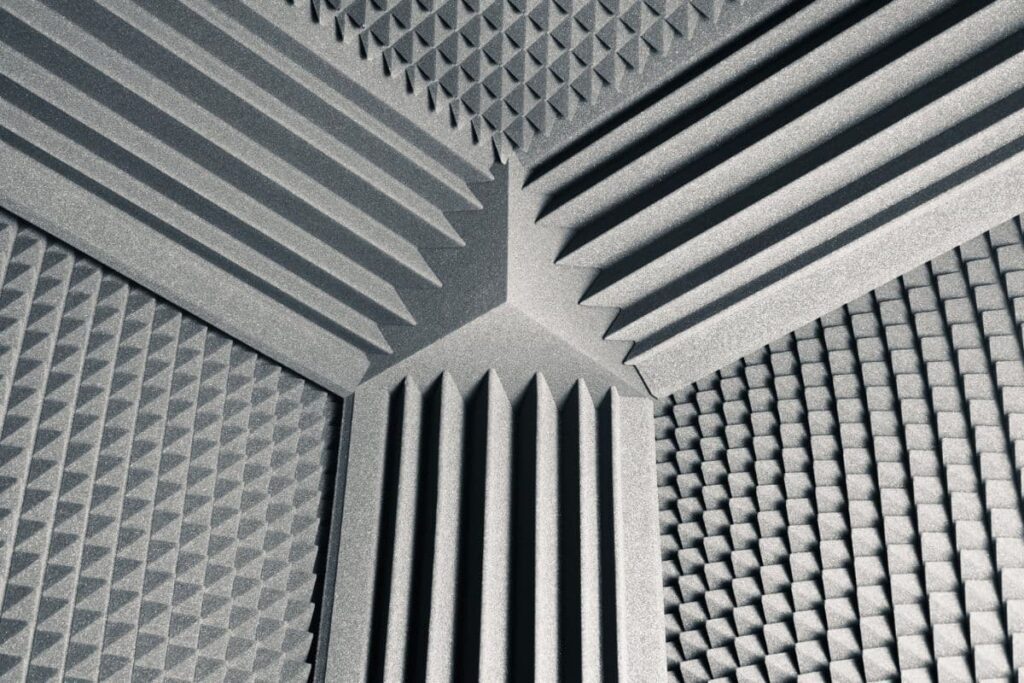Setting up a recording room or home theater is easier and more cost-efficient than ever. However, we want to ensure we optimize the room’s acoustics for the best performance. For lower-end frequencies, do bass traps make a difference?
Bass traps significantly dampen lower frequency sound waves. They work by absorbing low-end notes that typically echo throughout a room. This absorption improves a room’s sound and recording quality by making bass notes clear and prominent.
Bass traps can be a significant investment. However, if your goal is to maximize the sound quality of a room, they provide excellent dampening for lower-end frequencies. Read more to learn about how bass traps work, their different kinds, and their best placement.
Table of Contents
- How Bass Traps Affect Sound
- What Are the Different Kinds of Bass Trap?
- What’s the Best Placement for a Bass Trap?
- Final Thoughts

How Bass Traps Affect Sound
To create a sound room or studio, we want to optimize the space to hear certain sounds over others. In general, the purpose of acoustics is to minimize ambient sounds that muddle the overall sound quality of a room.
Anytime we produce noise, whether the melodic notes from a guitar or running a vacuum cleaner, sound waves move through the air. These waves disrupt the pressure of the surrounding air and continue to move until they dissipate.
The pitch, how high or low a sound is, depends on the wave’s length. The shorter a wavelength, the more frequently it reverberates throughout the air. Longer waves, because they make fewer cycles across the same distance, sound lower than shorter waves.
Additionally, lower frequency sound waves (which I will refer to as “bass notes”) travel further before they dissipate. In other words, they contribute more to ambient noises than higher frequency notes. Bass traps are porous or resonating structures designed to absorb the reverberating effects of bass notes.
What Are the Different Kinds of Bass Trap?
Depending on the size and purpose of your room, you’ll want the right bass trap to absorb reverberating bass notes adequately. While all are effective, each has advantages and disadvantages to consider.
For example, are you building a commercial-grade recording studio or transitioning your garage into a Friday night jam space? Knowing what sound quality you desire and how much you’re willing to pay for it will determine the best bass trap for you.
Porous Bass Traps
Porous bass traps are made of foam or fiberglass with a maze of pores to diffuse bass notes traveling throughout a room. As bass notes enter the foam mesh, they slow down and convert into heat against the friction of the trap.
The main advantages of porous bass traps are that they are cost-effective, easy to set up, and offer versatile sound coverage. The range of notes the foam can absorb is dependent on its thickness.
In general, porous traps are thick enough to cover mid-to-high-range bass notes. While this coverage offers versatility, these traps have the disadvantage of not being able to absorb lower-end bass notes as well as resonating or panel absorbers.
Panel Bass Traps
Another cost-effective (or even DIY) option is using panel bass traps. Where porous traps diffuse the sound through a mesh network, panels intercept the soundwaves and disperse them across a membrane.
Their function is similar to the effect of throwing a stone into water, which dissipates the energy as waves rippling outwards. As sound waves hit the panel, the energy is spread throughout the panel and diffuses, eliminating excess sound.
Panel traps offer a reasonable middle ground between porous and resonating bass traps. They provide easy installation and maintenance. However, their design limits their range of sound absorption, and they need to be tuned to cover specific frequency ranges.
Resonating Bass Traps
Where porous and panel traps are cost-effective, resonating traps are costly and effective. Despite the higher price tag, resonating traps are designed to hit specific frequencies in a room. What they lack in versatility, they make up in specificity.
Resonating bass traps have a diaphragmatic material inside with a small opening. As bass notes travel throughout a room, they resonate with the bass trap. Resonating traps at the right frequency cancel out bass notes traveling through space.
Unlike porous traps, resonating bass traps require knowing which frequencies reverberate through a room and tuning them to those frequencies. Further, you may need several different resonating traps to cover the frequencies of your space.
Fortunately, resonating bass traps take up little space and, due to their specificity, go excellently in conjunction with other kinds of bass traps.
What’s the Best Placement for a Bass Trap?
Bass traps are designed to absorb lower-end sound waves and reduce reverb. But what is the best placement for traps in your studio?
In general, the room’s corners are the best place to trap bass notes because that is where low-end sounds collect. Additional traps, especially resonating ones, can be placed on the rear wall to diffuse supra-low-end notes.
Start With the Corners
When we consider where bass notes travel, we notice that they bounce off solid surfaces continuously until they diffuse. In practice, bass notes “collect” in a room’s corners after bouncing against the room’s walls so many times.
Further, placing bass traps in the corners gives the most significant surface area to absorb reverberating bass notes. Whether it’s full foam or panel traps, the space behind the trap provides additional room for bass notes to diffuse.
The best corner bass traps are foam because of their versatility and setup. Further, thicker foam absorbs lower-end notes, and the extra corner space allows for more extensive and efficient traps. You can use panel traps, although you’ll need to know which frequencies to tune for your studio.
Apply Additional Traps Along the Rear Wall
The best practice is to start with foam corner traps and test the room’s sound quality. If you want to maximize your bass absorption, consider adding traps to the rear wall of your studio.
While rear traps aren’t necessary for a home studio or DIY setup, they can clean up lower-end frequencies the corner bass traps may have missed.
The best rear trap options are resonating or panel bass traps that can hit the specific frequencies you want. Using these alongside porous traps in the corners will give your room the best overall sound coverage.
Now, bass traps are only a part of the effort you need to put in to soundproof your home studio. I’ve discussed the entire process in a complete guide. Don’t miss it. The Ultimate Guide to Soundproofing a Home Studio
Final Thoughts
Having the highest quality sound is imperative when creating your home theater or recording studio. Fortunately, you can improve sound quality by reducing reverb with a suitable bass trap.
Bass traps absorb lower frequency sound waves that travel and bounce throughout a room. They eliminate ringing, suck-outs, and booming noises, presenting a clean sound all around.
While there are many different options for bass traps, the best practice is to start with corner foam traps and apply rear wall resonating traps later to absorb lower-end frequencies.
- Review of the ALABS IRON MINI-WL: A Powerhouse Wireless Microphone - October 4, 2023
- What is a Saturator in Music Production: A Brief Explanation - May 11, 2023
- What Are Rotary DJ Mixers? An Overview - May 11, 2023
SoundStudiomagic.com is a participant in the Amazon Services LLC Associates Program, an affiliate advertising program designed to provide a means for sites to earn advertising fees by advertising and linking to Amazon.com. We also participate in other affiliate programs which compensate us for referring traffic.

